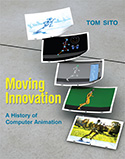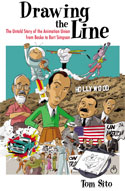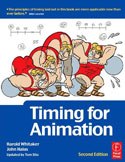“ Liberté, fraternité, closed-shoppité
Issue: 114
Posted: 10 April 07
John Newsinger
Tom Sito, Drawing the Line: The Untold Story of the Animation Unions from Bosko to Bart Simpson (University of Kentucky Press, 2006), £16.50
On 27 May 1941 one of Walt Disney’s top animators, Art Babbitt, the creator of Goofy, was escorted from the studio premises by company guards, sacked for his union activities. The next day nearly 400 animators, members of the Screen Cartoonists’ Guild, walked out on strike. The dispute was extremely bitter. On one occasion Art Babbitt and Walt Disney had to be pulled off each other after a picket line confrontation. Pickets carried placards showing Pluto with the slogan ‘I’d rather be a dog than a scab’. Every Wednesday the animators at the nearby Warners studio, who had won union recognition after a six‑day lockout earlier that year, marched to the Disney picket line to show their solidarity. Led by Chuck Jones, the creator of Roadrunner (beep! beep!), they marched dressed as French revolutionaries, carrying a banner that read ‘Liberté, fraternité, closed‑shoppité’.
Eventually Disney was forced to surrender, and the strikers returned to work triumphant on 21 September. Pay was more than doubled. Although Disney was reconciled to recognising the union, he was never to forgive the strike leaders. Even after Disney was long dead, when Art Babbitt was invited to lecture at the California Institute of the Arts in 1974, the Disney Corporation threatened to withdraw all its funding if the invitation was not withdrawn.
While the Disney strike effectively completed the unionisation of American animation, it was not the first serious dispute in the industry. In May 1937 animators at the Fleischer Studio in New York (they produced the Betty Boop and Popeye cartoons) had walked out on strike. This was also a bitter conflict. On a number of occasions the strikers occupied the foyer of the Paramount cinema in Times Square singing ‘I’m Popeye the union man’. The picket line was regularly reinforced by New York dockers. Eventually, in September, the company surrendered, conceding union recognition, a 20 percent pay rise, a shorter working week, sick pay and paid holidays. Both the Fleischer and the Disney strikes were part of the great labour revolt that swept American industry in the late 1930s into the 1940s. The unions were a power in the land.
In his marvellous book, Drawing the Line, Tom Sito tells the story of the struggle to unionise American animation. Both union man and animator, Sito recounts his own first uneasy encounter with trade unionism in the 1970s. When starting work as an animator, he had swallowed the line that if you had talent you did not need a union. As he puts it, ‘It wasn’t until after years of being cheated, laid off, and being assured that I was part of a “family”, then cheated and laid off some more, that I came to understand what my union was trying to do for me.’ Now he has written a history of the animation unions and, in the process, has uncovered a ‘hidden history, a people’s history of animation’. In fact the book is more than that. It also provides a witty, passionate, radical insider’s view of the American film industry that is indispensable reading for anyone interested in the cinema.
After chronicling the heroic struggles of the 1930s and 1940s (the anti‑capitalist sentiment of the time is demonstrated, according to Sito, by the success of the song ‘Don’t Tell my Mother I Work on Wall Street, she Thinks I Play the Piano in a Whorehouse’), he explores the grimmer years of McCarthyism and the Hollywood blacklist. Even the man who wrote the song ‘Somewhere Over the Rainbow’ for The Wizard of Oz, Yip Harburg, was blacklisted, an episode, as Sito realises, that is rich in symbolism. With solidarity banned by the Taft-Hartley Act and the unions on the defensive, the 28‑week 1947 Terrytoons lockout was to end in a crushing defeat.
Sito examines the impact of television on the industry and the problem that ‘runaway’ production posed by the end of the 1970s. Studios were exporting work and the unions attempted to stop the flight of animation jobs. In the Runaway Strike of 1979, they caught the studios unprepared and won concessions. In 1982 the studios struck back and inflicted a crushing defeat. Union membership fell from over 2,000 to 866. The export of work continued. At the time of the Tiananmen Square massacre in 1989, Disney was having work on The Little Mermaid completed in Communist China. Cheap labour trumped anti-Communism every time.
Sito laments, in particular, the failure of the animation unions to win residuals (payments for repeat showings, for example on TV). The Screen Actors Guild had won residuals for its members (after strike action led and sold out by Ronald Reagan) in 1960, but the animation unions had never taken the issue seriously enough. The result is, as Sito points out, that all those whose voices are used on Beauty and the Beast, including backing singers, receive substantial payments from the huge profits the film continues to generate. But the men and women who actually drew the cartoon only received their salaries and bonuses.
Sito identifies the animators’ perception of themselves as artists as one of the big obstacles to union consciousness. Just as when he first started work, young animators believe that if you have talent you don’t need a union. This is why on The Simpsons, while every other aspect of production was unionised, the 400 animators did not get a union agreement until 2004, after the cartoon had been in production for 15 years. Young animators rejected the union out of loyalty to ‘their hip studio director with his earring and Save the Whale T-shirt’ and did not see the ‘old robber barons pulling the strings’, the robber baron in this particular instance being Rupert Murdoch.
The ‘computer generated imagery’ (CGI) revolution poses new opportunities and dangers for the animation unions. Sito himself has been involved in responding to these. Is CGI live action special effects or animation? Sito has no doubts himself. As he puts it, ‘The animation labour unions have to grow and diversify or die.’”
Issue: 114
Posted: 10 April 07
John Newsinger
Tom Sito, Drawing the Line: The Untold Story of the Animation Unions from Bosko to Bart Simpson (University of Kentucky Press, 2006), £16.50
On 27 May 1941 one of Walt Disney’s top animators, Art Babbitt, the creator of Goofy, was escorted from the studio premises by company guards, sacked for his union activities. The next day nearly 400 animators, members of the Screen Cartoonists’ Guild, walked out on strike. The dispute was extremely bitter. On one occasion Art Babbitt and Walt Disney had to be pulled off each other after a picket line confrontation. Pickets carried placards showing Pluto with the slogan ‘I’d rather be a dog than a scab’. Every Wednesday the animators at the nearby Warners studio, who had won union recognition after a six‑day lockout earlier that year, marched to the Disney picket line to show their solidarity. Led by Chuck Jones, the creator of Roadrunner (beep! beep!), they marched dressed as French revolutionaries, carrying a banner that read ‘Liberté, fraternité, closed‑shoppité’.
Eventually Disney was forced to surrender, and the strikers returned to work triumphant on 21 September. Pay was more than doubled. Although Disney was reconciled to recognising the union, he was never to forgive the strike leaders. Even after Disney was long dead, when Art Babbitt was invited to lecture at the California Institute of the Arts in 1974, the Disney Corporation threatened to withdraw all its funding if the invitation was not withdrawn.
While the Disney strike effectively completed the unionisation of American animation, it was not the first serious dispute in the industry. In May 1937 animators at the Fleischer Studio in New York (they produced the Betty Boop and Popeye cartoons) had walked out on strike. This was also a bitter conflict. On a number of occasions the strikers occupied the foyer of the Paramount cinema in Times Square singing ‘I’m Popeye the union man’. The picket line was regularly reinforced by New York dockers. Eventually, in September, the company surrendered, conceding union recognition, a 20 percent pay rise, a shorter working week, sick pay and paid holidays. Both the Fleischer and the Disney strikes were part of the great labour revolt that swept American industry in the late 1930s into the 1940s. The unions were a power in the land.
In his marvellous book, Drawing the Line, Tom Sito tells the story of the struggle to unionise American animation. Both union man and animator, Sito recounts his own first uneasy encounter with trade unionism in the 1970s. When starting work as an animator, he had swallowed the line that if you had talent you did not need a union. As he puts it, ‘It wasn’t until after years of being cheated, laid off, and being assured that I was part of a “family”, then cheated and laid off some more, that I came to understand what my union was trying to do for me.’ Now he has written a history of the animation unions and, in the process, has uncovered a ‘hidden history, a people’s history of animation’. In fact the book is more than that. It also provides a witty, passionate, radical insider’s view of the American film industry that is indispensable reading for anyone interested in the cinema.
After chronicling the heroic struggles of the 1930s and 1940s (the anti‑capitalist sentiment of the time is demonstrated, according to Sito, by the success of the song ‘Don’t Tell my Mother I Work on Wall Street, she Thinks I Play the Piano in a Whorehouse’), he explores the grimmer years of McCarthyism and the Hollywood blacklist. Even the man who wrote the song ‘Somewhere Over the Rainbow’ for The Wizard of Oz, Yip Harburg, was blacklisted, an episode, as Sito realises, that is rich in symbolism. With solidarity banned by the Taft-Hartley Act and the unions on the defensive, the 28‑week 1947 Terrytoons lockout was to end in a crushing defeat.
Sito examines the impact of television on the industry and the problem that ‘runaway’ production posed by the end of the 1970s. Studios were exporting work and the unions attempted to stop the flight of animation jobs. In the Runaway Strike of 1979, they caught the studios unprepared and won concessions. In 1982 the studios struck back and inflicted a crushing defeat. Union membership fell from over 2,000 to 866. The export of work continued. At the time of the Tiananmen Square massacre in 1989, Disney was having work on The Little Mermaid completed in Communist China. Cheap labour trumped anti-Communism every time.
Sito laments, in particular, the failure of the animation unions to win residuals (payments for repeat showings, for example on TV). The Screen Actors Guild had won residuals for its members (after strike action led and sold out by Ronald Reagan) in 1960, but the animation unions had never taken the issue seriously enough. The result is, as Sito points out, that all those whose voices are used on Beauty and the Beast, including backing singers, receive substantial payments from the huge profits the film continues to generate. But the men and women who actually drew the cartoon only received their salaries and bonuses.
Sito identifies the animators’ perception of themselves as artists as one of the big obstacles to union consciousness. Just as when he first started work, young animators believe that if you have talent you don’t need a union. This is why on The Simpsons, while every other aspect of production was unionised, the 400 animators did not get a union agreement until 2004, after the cartoon had been in production for 15 years. Young animators rejected the union out of loyalty to ‘their hip studio director with his earring and Save the Whale T-shirt’ and did not see the ‘old robber barons pulling the strings’, the robber baron in this particular instance being Rupert Murdoch.
The ‘computer generated imagery’ (CGI) revolution poses new opportunities and dangers for the animation unions. Sito himself has been involved in responding to these. Is CGI live action special effects or animation? Sito has no doubts himself. As he puts it, ‘The animation labour unions have to grow and diversify or die.’”
-- John Newsinger
_______________




